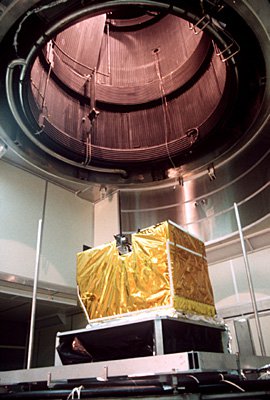MISR Instrument, a Year from Launch, Delivered for Spacecraft Integration
The following is the text of an article published in the JPL Universe (JPL's in-house newsletter) on June 13, 1997.
The picture shows the MISR instrument seated on the end bell of the thermal vacuum chamber in JPL's 3-meter Space Simulator Facility. Testing was completed in mid-May 1997, and verified the instrument performance over a range of temperatures. Select the picture to display a full-size version of this photograph -- 500 x 740 pixels, 248 kilobytes.
JPL's Multi-angle Imaging SpectroRadiometer (MISR) instrument, to be carried aboard Earth Observing System (EOS) AM-1 mission, has been shipped by surface transport to the spacecraft builder, Lockheed Martin Astro Space of Valley Forge, Pennsylvania, for integration onto the spacecraft. It arrived on May 26. The delivery is the first of several major milestones in preparation for the late-June 1998 launch into polar orbit from Vandenberg Air Force Base. The
EOS spacecraft series, of which AM-1 is the flagship, is a component of the Mission to Planet Earth, and is managed for NASA by Goddard Space Flight Center, Greenbelt, Maryland.
MISR measurements are designed to improve our understanding of Earth's ecology and climate. The illumination source for MISR imagery is reflected sunlight, and a detailed understanding of how sunlight is scattered in different
directions is necessary in order to determine how changes in the amounts, types, and distribution of clouds, airborne particulates, and surface covers can affect our climate.
Most spaceborne imaging instruments view Earth straight down. MISR takes the novel approach of imaging Earth in nine different view directions to infer the physical characteristics of the observed scenes. Each of MISR's nine
cameras acquires images at four wavelengths (blue, green, red, and near-infrared). JPL scientists and engineers have fabricated and tested the cameras to stringent specifications, implemented state-of-the-art calibration techniques, and successfully met many technical challenges in building this sophisticated instrument. MISR data will be acquired globally at a rate of 6.6 Megabits per second, with a ground footprint of 275 meters (900 feet.) The instrument has been designed for a mission duration of six years.
JPL's MISR will share the EOS AM-1 platform with four other instruments: the Advanced Spaceborne Thermal Emission and Reflectance (ASTER) radiometer, provided by Japan; the Clouds and Earth's Radiant Energy System (CERES) instrument, built by TRW for NASA Langley Research Center, Hampton, Virginia; the Moderate Resolution Imaging Spectrometer (MODIS), built by Santa Barbara Remote Sensing for NASA Goddard Space Flight Center; and the Measurements of Pollution in the Troposphere (MOPITT), provided by Canada.
The MISR co-investigators and their associates include scientists from JPL, other NASA centers, and universities and research centers in the United States, Canada, England, France, and Italy. The MISR Project is managed by Terrence H. Reilly of the Space and Earth Sciences Program Directorate (SESPD.) The Instrument Manager is Jewel C. Beckert, also of SESPD.
Besides delivering the MISR flight instrument hardware and software, JPL is building a multi-angle aircraft camera (AirMISR), preparing for scientific analysis of MISR data, conducting a validation program of in situ field measurements, and developing the ground data processing software which will be delivered later this year to NASA Langley Research Center. This complex software system will process MISR data in automated fashion to turn the instrument digital data into calibrated radiances, geolocate and co-register the imagery from the nine cameras, establish data quality metrics, and perform mathematical retrievals to obtain the geophysical products of the experiment.
The ground data processing component of the project is managed by Graham W. Bothwell of SESPD, and is a collaborative effort of Earth and Space Sciences and Observational Systems Divisions.
Including its cameras, on-board calibration hardware, electrobics, cabling and support structure, the MISR instrument is approximately the size of a small desk, and has a mass of 149 kilograms (328 pounds.) Recently, JPL engineers have been studying designs that would reduce the size of future versions of MISR by a factor of three or more while maintaining most key performance objectives.
